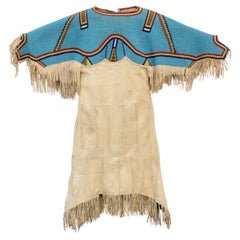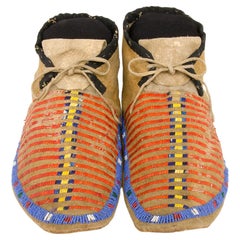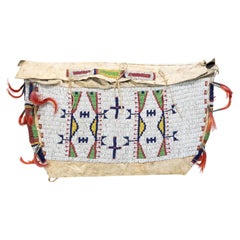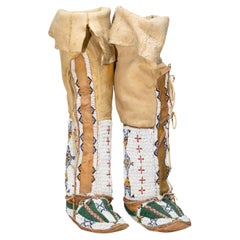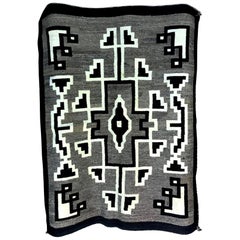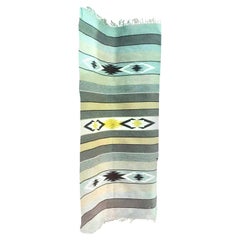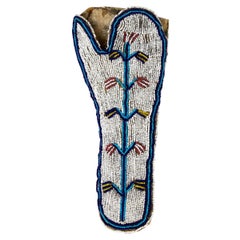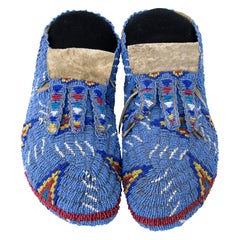Sioux Indian Art Furniture
to
1
15
15
12
3
3
11
10
10
10
2
15
15
15
15
15
13
8,904
3,909
2,530
2,221
Creator: Sioux Indian Art
Circa 1880 Sioux Beaded Deer Hide Dress, Plains Native American, Fringe
By Sioux Indian Art
Located in Denver, CO
This extraordinary antique Sioux beaded hide dress, dating to circa 1880, is a rare and authentic example of Plains Indian textile art. Handcrafted from native-tanned deer hide, the ...
Category
Late 19th Century American Native American Antique Sioux Indian Art Furniture
Materials
Hide, Beads
Handcrafted 1870s Sioux Moccasins, Plains Indian Quillwork & Beaded Buckskin
By Sioux Indian Art
Located in Denver, CO
This rare and authentic pair of antique Sioux moccasins dates to the 1870s, during the late Classic Period of Native American artistry (circa 1650–1875). Handcrafted by a Plains Indi...
Category
19th Century American Native American Antique Sioux Indian Art Furniture
Materials
Animal Skin, Hide, Glass, Beads
$3,800 Sale Price / set
20% Off
Native American Sioux Beaded Teepee Bag
By Sioux Indian Art
Located in Coeur d'Alene, ID
Native American Sioux beaded teepee bag. Having beaded front, sides and top. Beadwork is mostly white with blue, yellow, red, and green forming traditional geometric design. Having t...
Category
Late 19th Century American Native American Antique Sioux Indian Art Furniture
Materials
Hide, Beads
19th Century Sioux Bow, Arrows and Beaded Quiver Case
By Sioux Indian Art
Located in Coeur d'Alene, ID
Sioux bow and quiver with beaded bands on top and bottom on both bow and quiver case. Bow 46" of bodack with original sinew string and three 24" matching arr...
Category
Late 19th Century American Native American Antique Sioux Indian Art Furniture
Materials
Other
Sioux Beaded Patriotic Doctor's Bag, Early 20th Century
By Sioux Indian Art
Located in Coeur d'Alene, ID
Patriotic Native American Sioux beaded doctor's bag. 62 American flags and crests. Large doctors bag; Sioux beaded. Came from a trading post in South Dakota; estimate first half 20th century, sold in the 1970's for $16,500. Bright, visual, patriotic and great condition for age (see photos). Beadwork over a vintage leather doctor's bag.
Period: 1st half 20th century
Origin: Sioux, Plains
Size: 10" x 12" x 18".
Family Owned & Operated
Cisco’s Gallery deals in the rare, exceptional, and one-of-a-kind pieces that define the history of America and the Old West. Our pieces range from American Indian to Cowboy Western and include original items of everyday life, commerce, art, and warfare that tamed America’s frontier. Our 14,000 square foot gallery opened in 1996 in beautiful Coeur d’Alene, Idaho.
Personal Service
Cisco’s operates on old fashioned values – honesty and integrity, and all of our items are backed by our money back guarantee. We appreciate the opportunity to earn your business. Whether you desire assistance with a jewelry purchase, choosing a gift, identification, or even selling – we hope to be your trusted source.
Native American beadwork native American Indian beadwork...
Category
Early 20th Century American Native American Sioux Indian Art Furniture
Materials
Leather
19th Century, Sioux Beaded High-Top Moccasins
By Sioux Indian Art
Located in Coeur d'Alene, ID
This is an outstanding set of authentic original beaded hide high-top / high-top moccasins with hard parfleche soles from the Sioux Native American Indians dating to circa 1880. The set shows stiff Indian tanned hide moccasins with hard parfleche rawhide soles and the tops being covered in period correct 1800’s glass trade seed beads that are sinew sewn in a traditional Buffalo track geometric pattern. The moccasins have a red ocher mineral pigment paint and are completely sinew rawhide sewn. The moccasins have sewn on high top / high-top leggings done in Indian tanned hide which is very stiff and has a sewn-on section at the top of Indian tanned Buffalo Bison hide...
Category
Late 19th Century American Native American Antique Sioux Indian Art Furniture
Materials
Hide, Beads
Native American Sioux Beaded Saddle Throw
By Sioux Indian Art
Located in Coeur d'Alene, ID
Native American Sioux saddle throw. Beaded on brain tanned elk hide and red stroud. Beadwork features a traditional "hourglass" design done in colors of blue, green, and white with s...
Category
Early 20th Century American Native American Sioux Indian Art Furniture
Materials
Hide, Beads
Authentic 19th Century Lakota Sioux Child's Bonnet
By Sioux Indian Art
Located in Coeur d'Alene, ID
Authentic and genuine 19th Century Lakota Sioux fully beaded child's bonnet. Sinew sewn with cotton calico (flour sack) lining. Made for own use. Very few made, and fewer survived. B...
Category
Late 19th Century American Native American Antique Sioux Indian Art Furniture
Materials
Cotton, Beads
Sioux Beaded Pipe Bag
By Sioux Indian Art
Located in Coeur d'Alene, ID
Sioux beaded pipe bag. Having large-beaded panels both sides on brain tanned buffalo. Bead patterns feature white background with green and blue tradition...
Category
Late 19th Century American Native American Antique Sioux Indian Art Furniture
Materials
Hide, Beads
$2,875
19th Century Cheyenne Beaded Moccasins
By Sioux Indian Art
Located in Coeur d'Alene, ID
Cheyenne fully beaded moccasins. Red, yellow and blue on white background. Soft soled brain tanned hide.
PERIOD: Late 19th Century
ORIGIN: Great Plai...
Category
Late 19th Century American Native American Antique Sioux Indian Art Furniture
Materials
Hide, Beads
19th Century Sioux Quilled Knife Sheath
By Sioux Indian Art
Located in Coeur d'Alene, ID
Quilled knife sheath with quilled drops, tin cones with yellow horsehair. With original collection tag. A very rare piece in this condition. Original tag reads "Knife sheath I bought from Mr. Corelson Marsh 1st - 1890 Pd 60 cts. Worth 2.00. Mr. Robb sent Me C. (Post - Trade form Ft Bennet Dakota. A valuable relic + very rare. Worked with colored porcupine quills. E Kaucher." Ex. Stalter Collection. Dr. Kenneth Stalter (1954-2012) grew up in Delaware County where he developed a lifelong interest in Native American tools...
Category
Mid-19th Century American Native American Antique Sioux Indian Art Furniture
Materials
Hide
19th Century Sioux Beaded Moccasins
By Sioux Indian Art
Located in Coeur d'Alene, ID
Sioux fully beaded moccasins. Red, white and blue with geometric stacked colors. Hard soles, cotton cuff edging.
Period: Late 19th Century
Origin: Gr...
Category
Late 19th Century American Native American Antique Sioux Indian Art Furniture
Materials
Hide, Beads
Roan Eagle, Wanbli Hito Warrior Ledger Drawing
By Sioux Indian Art
Located in Coeur d'Alene, ID
Roan Eagle, Wanbli Hito (Lakota, b. 1863) ledger drawing, untitled. Warrior on horseback. Pencil and watercolor; 7 1/4" x 12". Framed. Wanbli Hito, also known as Roan Eagle, was a La...
Category
19th Century American Native American Antique Sioux Indian Art Furniture
Materials
Paper
Sioux Beaded Pictorial Tunic
By Sioux Indian Art
Located in Coeur d'Alene, ID
Sioux pictorial beaded tunic. Thread sewn and assembled using multiple hide panels. Beaded with 12 horses and 10 stars. Initials "C.S.C." Colors of deep red white hearts, various blu...
Category
19th Century American Native American Antique Sioux Indian Art Furniture
Materials
Hide, Beads
$34,500
Native American Sioux Catlinite T Pipe
By Sioux Indian Art
Located in Coeur d'Alene, ID
Sioux catlinite T pipe with fluted base and top. Has been smoked, with original stem. Collected by Charles Graves, Indian agent in 1928, South Dakota. Authentic.
Period: First quart...
Category
Early 20th Century American Native American Sioux Indian Art Furniture
Materials
Other
Related Items
Indigenous Southwest Native American Indian Navajo Handwoven Rug Blanket
By Native American Art
Located in Studio City, CA
A nicely made, handwoven Native American Navajo green, beige and brown rug/blanket
Would be a nice addition to your Native American collection or make for an eye-catching accent pie...
Category
20th Century American Native American Sioux Indian Art Furniture
Materials
Wool
$1,245
H 38 in W 48 in D 0.25 in
Native American Navajo Handwoven Wool Rug or Mat
By Native American Art
Located in Studio City, CA
A nicely hand loomed Native American (likely Navajo) rug. Wonderfully designed with vivid colors and geometrical patterns. Would make for a nice additio...
Category
20th Century North American Native American Sioux Indian Art Furniture
Materials
Wool
Fine Long Vintage Native American graduated Navajo Silver bead Necklace 30 inch
Located in London, GB
Long graduated Navajo stamped silver bead Necklace 30 inch
circa 1960s.
.
Category
20th Century American Sioux Indian Art Furniture
Materials
Silver
$856
H 29.93 in W 1.19 in D 0.4 in
Native American Sioux Beaded Saddle Throw
By Sioux Indian Art
Located in Coeur d'Alene, ID
Native American Sioux saddle throw. Beaded on brain tanned elk hide and red stroud. Beadwork features a traditional "hourglass" design done in colors of blue, green, and white with s...
Category
Early 20th Century American Native American Sioux Indian Art Furniture
Materials
Hide, Beads
Beaded Native American Yakima Dress
By Native American Art
Located in Coeur d'Alene, ID
Native American Yakama Indian dress with fully beaded cape, same both sides. Brain/smoked tanned with replaced chest of commercial tanned. Bright yellow background with rose floral d...
Category
Early 20th Century American Native American Sioux Indian Art Furniture
Materials
Hide, Leather, Beads
Early 20th Century Acoma Pueblo Pottery Olla
By Navajo
Located in Bradenton, FL
A very fine Acoma Pueblo, early 20th century polychrome Olla. Painted dark brown and orange design on a white ground, with large areas fired gray. Shrinka...
Category
Early 20th Century Native American Sioux Indian Art Furniture
Materials
Clay
Sioux Native Dragonfly Beaded Moccasins
Located in Coeur d'Alene, ID
Sioux moccasins with dragonflies. Fully beaded, including soles.
Fully beaded moccasins were made as special gifts for elders, respected individuals, or during rites of passages for ...
Category
1880s American Native American Antique Sioux Indian Art Furniture
Materials
Beads
Vintage Navajo Yei Handwoven Wool Rug, American Southwest, 20th Century
By Navajo
Located in Morristown, NJ
Navajo Yei Handwoven Wool Rug, American Southwest, 20th Century
Description:
A vibrant and finely handwoven Navajo Yei rug, originating from the American Southwest, likely mid-20th ...
Category
1940s American Native American Vintage Sioux Indian Art Furniture
Materials
Wool, Cotton
$2,750
H 36.5 in W 58 in D 0.2 in
Unusual 20th Century Kachina "style" Doll of a Navajo Figure with Large Hands
Located in Van Nuys, CA
Painted cottonwood Kachina "style" doll depicting a Navajo, circa 1940s. It is in good condition, with bright color. Kachina dolls were usually created to teach Hopi children the var...
Category
1940s American Native American Vintage Sioux Indian Art Furniture
Materials
Wood
$360 Sale Price
20% Off
H 7.5 in W 4.5 in D 4.5 in
Antique Lakota Sioux Doctor’s Bag, 19th C Buffalo Hide with Trade Beadwork
By Native American Art
Located in Denver, CO
This antique 19th-century Lakota (Sioux) doctor’s bag is an exceptional example of Plains Indian beadwork artistry, crafted from native-tanned buffalo hide and intricately adorned with Venetian glass trade beads. The beadwork is sinew-sewn and features a vibrant mix of white-hearts, dark blue, greasy yellow, translucent blue, and faceted metal beads, all set against a bright white field for striking contrast.
Both sides of the bag are fully beaded, each showcasing unique traditional design elements such as arrow motifs, crosses, and geometric patterns, symbolizing strength, direction, and protection. The original metal clasp and handle remain intact, further enhancing its authenticity and historic value.
Though referred to as “doctor’s bags,” these pieces were not used for medical purposes. Instead, they were gifted to physicians by Native communities—particularly as tokens of gratitude for care or assistance rendered to tribal members during the late 19th century. As such, they hold both cultural and ceremonial significance.
The Lakota, one of the three major divisions of the Sioux Nation, are a nomadic Plains tribe known for their highly developed beadwork traditions. Residing in the Great Plains across present-day South Dakota, North Dakota, Nebraska, Montana, and Wyoming, the Lakota are renowned for creating deeply symbolic and intricately detailed art that reflects their spiritual beliefs, cultural identity, and connection to the land.
This rare beaded doctor’s bag...
Category
Late 19th Century American Native American Antique Sioux Indian Art Furniture
Materials
Hide, Beads
$5,250
H 7 in W 12 in D 5.5 in
19th Century Sioux Beaded Moccasins
By Sioux Indian Art
Located in Coeur d'Alene, ID
Sioux fully beaded moccasins. Red, white and blue with geometric stacked colors. Hard soles, cotton cuff edging.
Period: Late 19th Century
Origin: Gr...
Category
Late 19th Century American Native American Antique Sioux Indian Art Furniture
Materials
Hide, Beads
Mid 20th Century Pueblo Original Paint Decorated Drum
Located in Los Angeles, CA
This fantastic rarity is in all original painted surface with the original handmade drum stick attached. The top of the drum has a painted eagle (Possibly added later) and the base h...
Category
Mid-20th Century American Native American Sioux Indian Art Furniture
Materials
Leather
Previously Available Items
Antique Sioux Gun Holster, Plains Indian Native American Beadwork, Circa 1890
By Sioux Indian Art
Located in Denver, CO
This beaded Sioux gun holster, dating from circa 1890, is a stunning example of 19th-century Native American beadwork from the Plains Indians. The holster ...
Category
19th Century American Native American Antique Sioux Indian Art Furniture
Materials
Hide, Beads
H 10.75 in W 4.75 in D 0.25 in
Moccasins, Early 20th Century, Sioux, Plains Indian, Pictorial Bead Work, Tepees
By Sioux Indian Art
Located in Denver, CO
Vintage Native American moccasins, Sioux (Plains Indian) ceremonial style, fully beaded including the soles. Hide, beaded with glass trade be...
Category
Early 20th Century American Native American Sioux Indian Art Furniture
Materials
Hide
H 4.75 in W 8.25 in D 10.25 in
Moccasins and Leggings, Sioux 'Plains', circa 1910, Native American Beadwork
By Sioux Indian Art
Located in Denver, CO
Northern Sioux moccasins and leggings, early 20th century Native American, Plains Indian beadwork. Constructed of native tanned hide with trade beads. ...
Category
Early 20th Century American Native American Sioux Indian Art Furniture
Materials
Hide
H 16.5 in W 16 in D 10.25 in
Antique Beaded Hide Dress, Sioux 'Plains Indian', circa 1880, Native American
By Sioux Indian Art
Located in Denver, CO
Antique Sioux (Plains Indian) beaded hide dress, circa 1880. Native tanned deer hide with glass trade beads adorning the yoke. Design elements include cross...
Category
19th Century American Native American Antique Sioux Indian Art Furniture
Materials
Hide
H 49 in W 42 in D 11 in
Sioux Dentalia Shell Choker and Breastplate
By Sioux Indian Art
Located in Coeur d'Alene, ID
Sioux man's dentalia shell choker and boys breastplate with brass and glass beads in shadowbox. Choker 15" x 1 1/2"Frame 13" x 6 1/2". Framed in walnut. ...
Category
19th Century American Native American Antique Sioux Indian Art Furniture
Materials
Shell
19th Century Native American Yanktonai Sioux Beaded Belt
By Sioux Indian Art
Located in Coeur d'Alene, ID
Yanktonai Sioux at Fort Peck fully beaded sinew sewn belt on brain tanned buffalo. Greasy yellows and red white hearts. As worn condition with a few edge bea...
Category
Late 19th Century American Native American Antique Sioux Indian Art Furniture
Materials
Beads
Yankton Sioux Beaded Moccasins
By Sioux Indian Art
Located in Coeur d'Alene, ID
Yankton Sioux men's fully beaded moccasins. Sinew sewn, parfleche soles, fringe trailers on heels. Very nice beadwork in yellow, white, blues and greens ...
Category
Late 19th Century American Native American Antique Sioux Indian Art Furniture
Materials
Other
Yankton Sioux Quilled Knife and Sheath
By Sioux Indian Art
Located in Coeur d'Alene, ID
Yankton Sioux quilled knife sheath with original dag knife having wing bone handle. Blue beaded edging with red beads interspersed. Tin cones with red hors...
Category
Mid-19th Century American Native American Antique Sioux Indian Art Furniture
Materials
Other
Antique Sioux 'Plains' Beaded Vest with Stand, 19th Century Native American Art
By Sioux Indian Art
Located in Denver, CO
Vintage 19th century Sioux (Plains Indian) Native American antique pictorial beaded hide vest, circa 1875-1900. Pictorial design includes tipi (teepee) motifs and geometric elements ...
Category
Late 19th Century American Native American Antique Sioux Indian Art Furniture
Materials
Hide
H 16.25 in W 19.75 in D 10.5 in
Antique Native American Drum & Beater, Sioux 'Plains Indian', Early 20th Century
By Sioux Indian Art
Located in Denver, CO
Vintage painted drum and beater, Native American, created by a member of the Sioux tribe (Plains Indian). The drum was constructed of rawhide stretched over a wood cylinder and is ha...
Category
Early 20th Century American Native American Sioux Indian Art Furniture
Materials
Hide
H 16.25 in W 13.75 in D 6 in
Pair of Antique Native American Beaded Possible Bags 'Tepee Bags', Sioux
By Sioux Indian Art
Located in Denver, CO
A pair of Sioux (Plains Indian) beaded possible bags (also referred to as tipi bags). Constructed of native tanned hide with glass trade beads, horse hair and tin-cone tinklers. Each...
Category
Late 19th Century American Native American Antique Sioux Indian Art Furniture
H 10.25 in W 13.5 in D 3.5 in
Classic Period Akicita 'Lakota Warrior Society' Fan, Plains, circa 1825-1850
By Sioux Indian Art
Located in Denver, CO
This is original Warrior material from the Lakota Sioux Warrior Society known as Akicita. A Classic Period (Pre-Reservation era) triangular shaped fan handle constructed of native ta...
Category
Mid-19th Century American Native American Antique Sioux Indian Art Furniture
Materials
Cowhide
H 16 in W 3.5 in D 0.75 in
Sioux Indian Art furniture for sale on 1stDibs.
Sioux Indian Art furniture are available for sale on 1stDibs. These distinctive items are frequently made of animal skin and are designed with extraordinary care. There are many options to choose from in our collection of Sioux Indian Art furniture, although beige editions of this piece are particularly popular. If you’re looking for additional options, many customers also consider furniture by Plateau Indians, Navajo Indian Art, and Apache Indian Art. Prices for Sioux Indian Art furniture can differ depending upon size, time period and other attributes — on 1stDibs, these items begin at $1,850 and can go as high as $35,000, while a piece like these, on average, fetch $5,250.
Creators Similar to Sioux Indian Art
Questions About Sioux Indian Art Furniture
- 1stDibs ExpertMay 3, 2024The father of modern Indian art is generally thought to be Raja Ravi Varma. Active during the late 18th and early 19th centuries, he was the first Indian artist widely known for producing paintings that depicted Indian subjects using the techniques of the European masters. Some of his most famous works include Bhishma on a Bed of Arrows, Bharat Mata, Jatayu Vadham and Lady in the Moonlight. On 1stDibs, shop a variety of Indian art.
